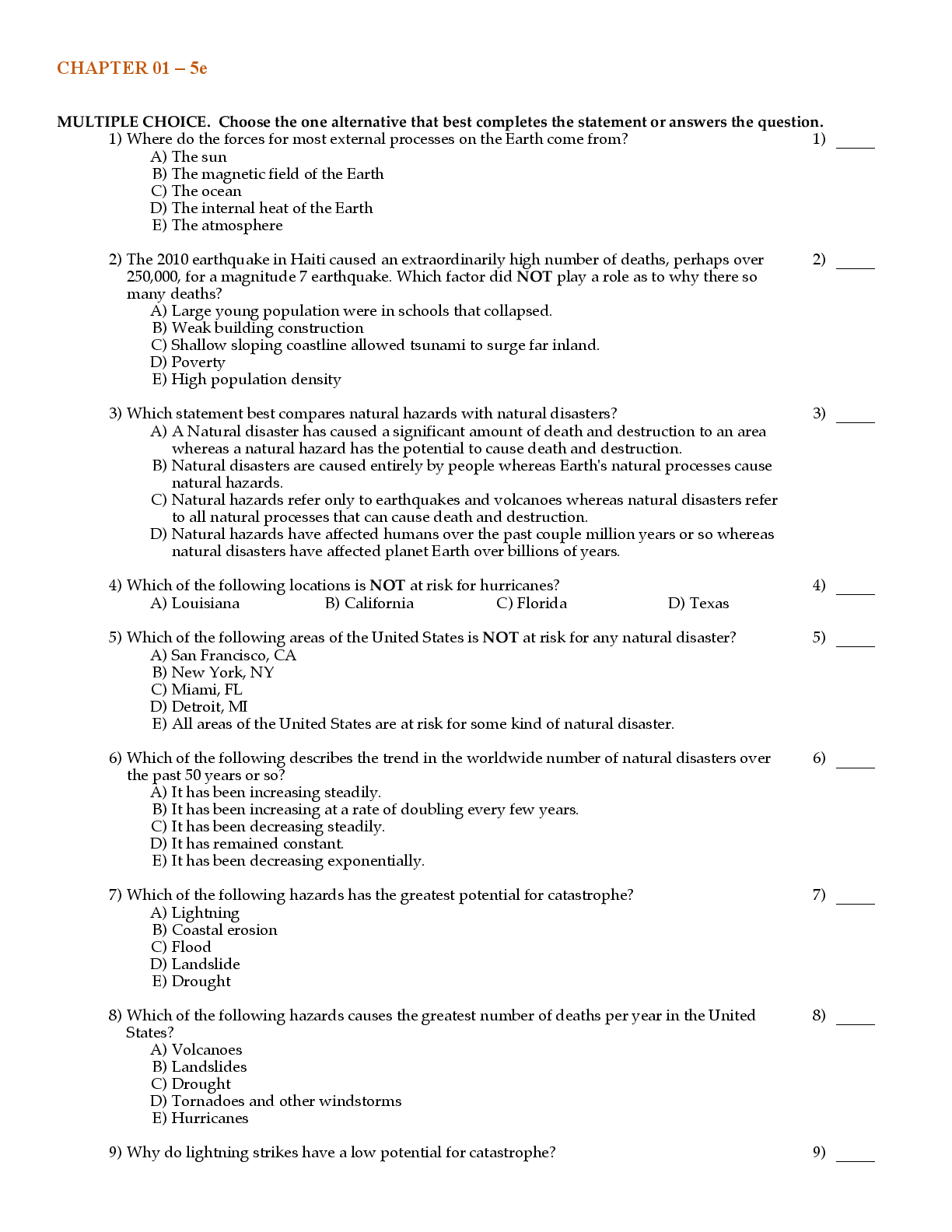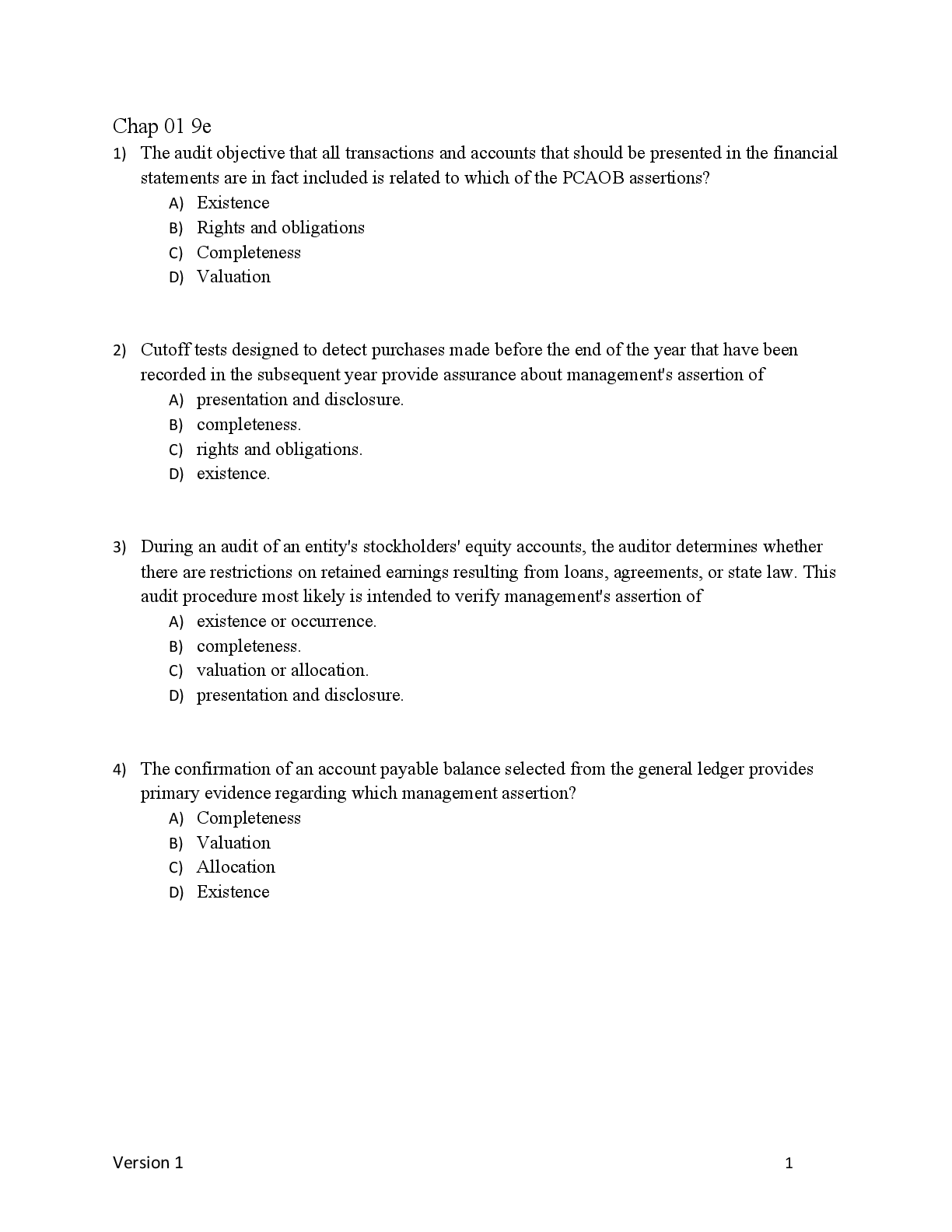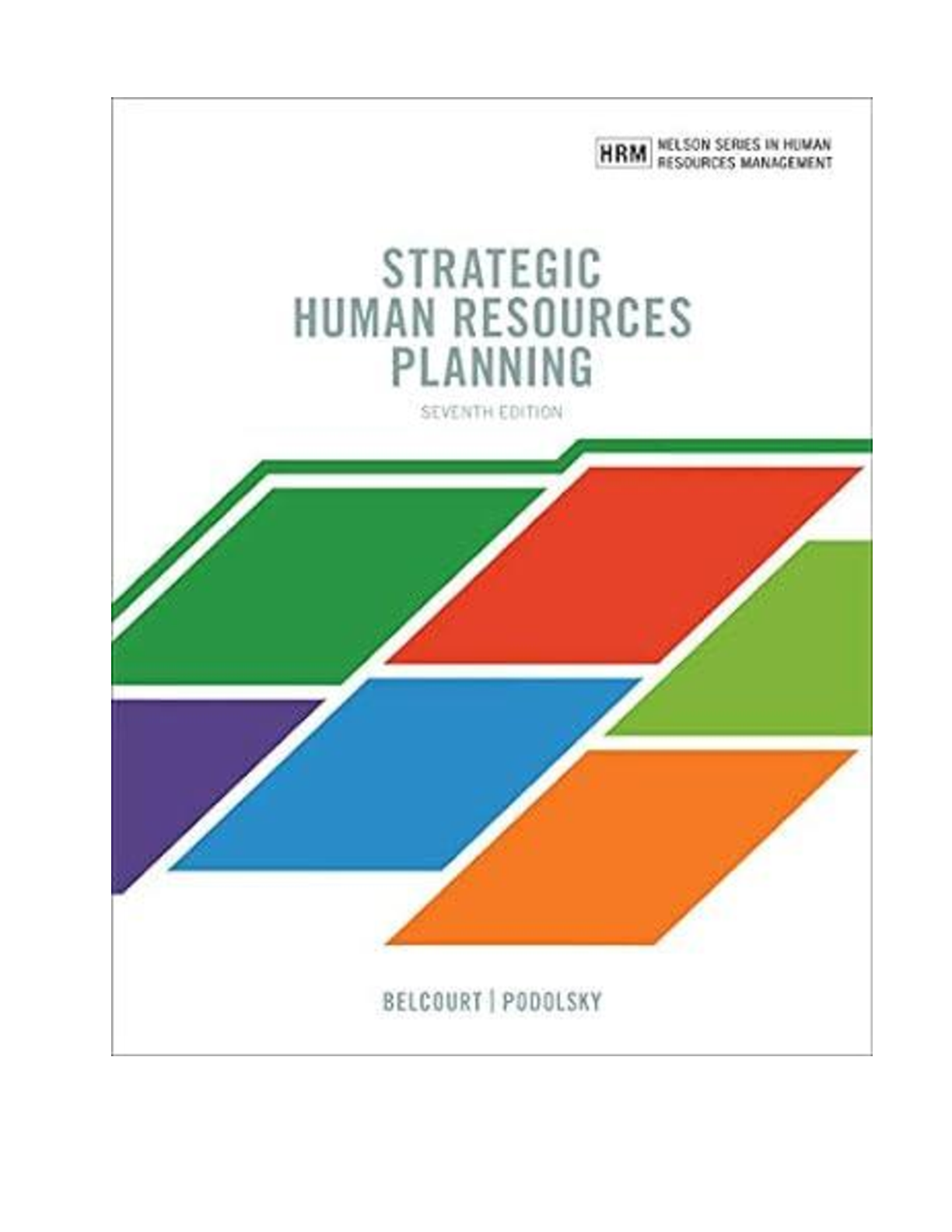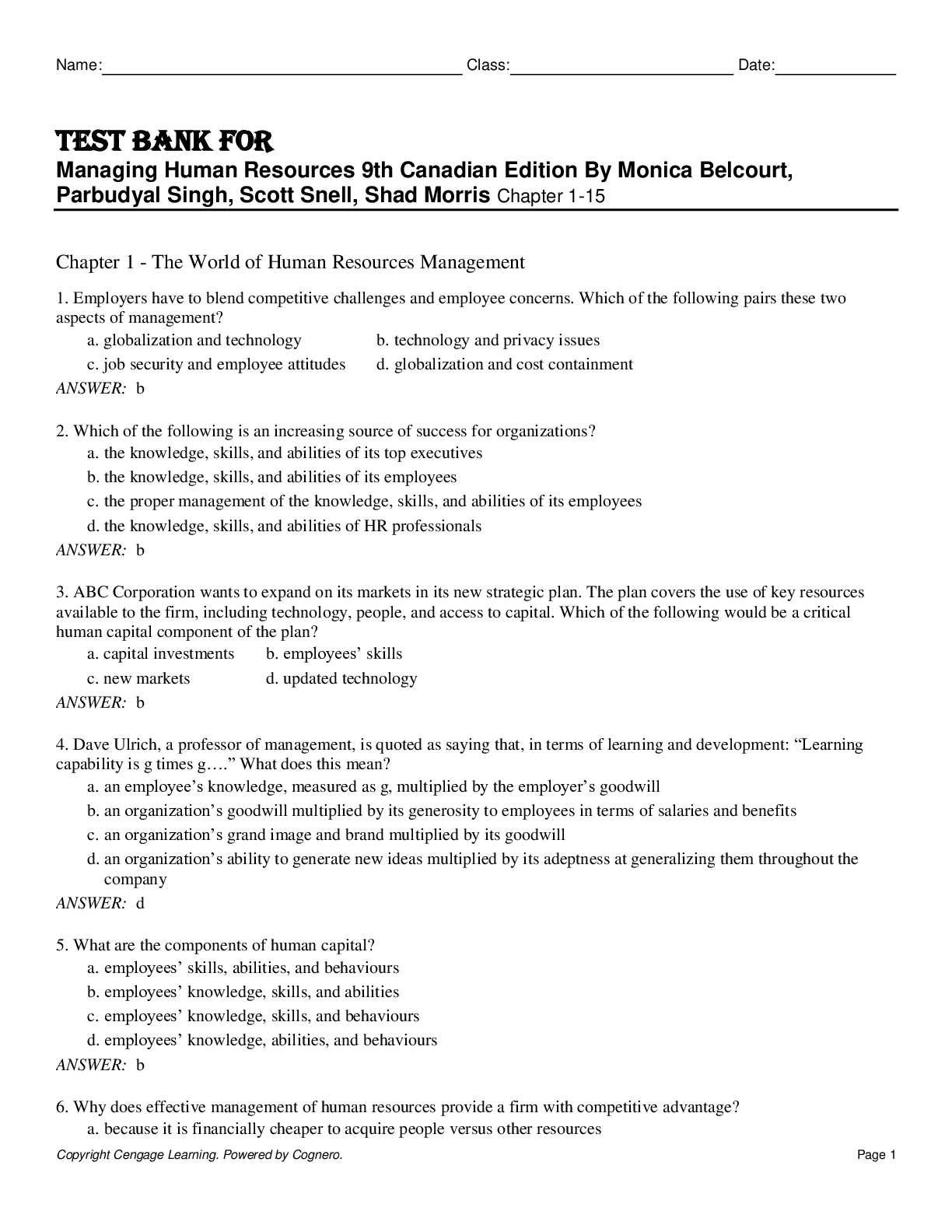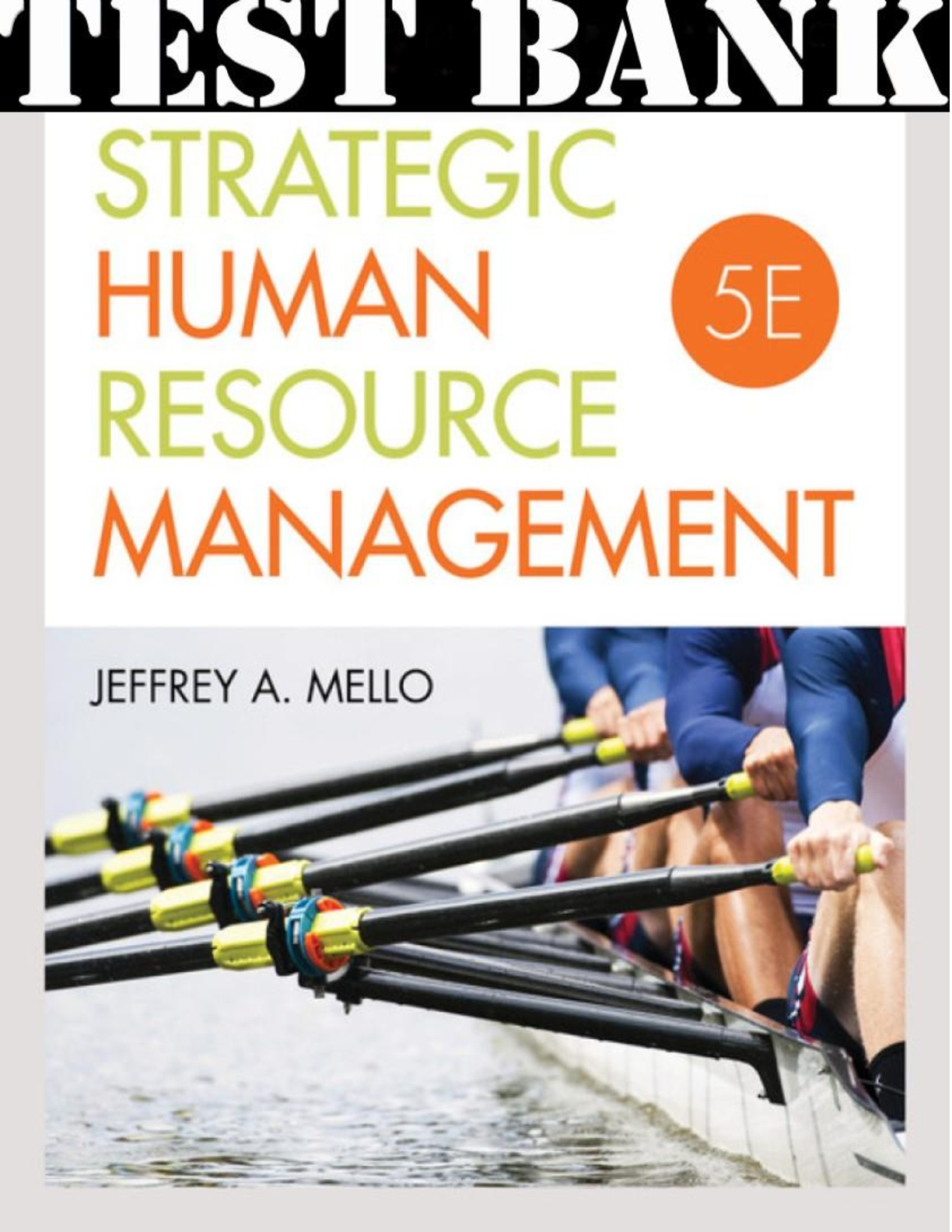Human Resource Management > TEST BANK > Test Bank for Strategic Human Resources Planning, 7th Edition by Monica Belcourt, Mark Podolosky (All)
Test Bank for Strategic Human Resources Planning, 7th Edition by Monica Belcourt, Mark Podolosky
Document Content and Description Below
Test Bank for Strategic Human Resources Planning, 7th Edition, 7e by Monica Belcourt, Kenneth McBey , Ying Hong, Margaret Yap TEST BANK ISBN-13: 9780176798086 Full chapters included Chapter 1 S... trategic Management Chapter Learning Outcomes Strategic Management at The Bay A Need for Strategic HRM Strategy Strategic Types Corporate Strategies Business Strategies The Strategic Planning Process 1. Establish the Mission, Vision, and Values 2. Develop Objectives 3. Analyze the External Environment 4. Identify the Competitive Advantage 5. Determine the Competitive Position 6. Implement the Strategy 7. Evaluate the Performance Benefits of Strategy Formulation Summary Key Terms Discussion Questions Exercises Case Study: Loblaw Companies Ltd. References Chapter 2 Aligning HR with Strategy Chapter Learning Outcomes HR Structure at Johnson and Johnson Strategic HRM Theories of the Strategic Management of Human Resources HRM Making Strategic Contributions The Contingency Perspective Behavioural Theory Strategic HR Planning The Importance of Strategic HR Planning Improved Goal Attainment Linking HR Processes to Strategy Corporate Strategy Leads to HR Strategy HR Competencies Lead to Business Strategy Reciprocal Interdependency Between HR Strategy and Business Strategy HR Becomes a Business Partner Strategic Partnering Becoming More Strategic HR Strategy Differentiation Characteristics of an Effective HRM Strategy Focus on Results Summary Key Terms Discussion Questions Exercises Case Study: Linking HR Practices to Performance References Chapter 3 Environmental Influences on HRM Chapter Learning Outcomes Environmental Scanning at GM Introduction Environmental Scanning Sources and Methods Sources of Information Methods of Forecasting Competitive Intelligence Challenges in Environmental Scanning Isolating the Critical from the Insignificant Environmental Factors Economic Climate Globalization Political and Legislative Factors Technological Factors Demographic Factors Social and Cultural Factors Stakeholders Responding to External Factors A Proactive Approach Summary Key Terms Discussion Questions Exercises: Scenario Planning Case Study: Work–Life Family Balance References Chapter 4 The HR Forecasting Process Chapter Learning Outcomes Workforce Planning in Canada What Is HR Forecasting? The Strategic Importance of HR Forecasting Increasing Organizational Flexibility Ensuring a Close Linkage to the Macro Business Forecasting Process Ensuring That Organizational Requirements Take Precedence Over Issues of Resource Constraint and Scarcity The Value of Human Capital to the Firm Generic Human Capital Firm-Specific Human Capital Human Capital Stock and Flows Key Human Capital Analyses Conducted by HR Forecasters Strategic Forecasting The Forecasting Process Forecasting Methods Environmental and Organizational Factors Affecting HR Forecasting HR Forecasting Time Horizons Reconciling Net HR Requirements Institute HR Programs and Policies Summary Key Terms Discussion Questions Exercise Case Study: Forecasting for Home Support Workers References Chapter 5 Determining HR Demand Chapter Learning Outcomes Increase in Uncertainty Around the Demand for Labour in Canada Forecasting Demand Certainty in Forecasting Volume and Complexity of Available Data Quantitative Methods Trend/Ratio Analysis Time Series Models Regression Analysis Structural Equation Modelling Qualitative Forecasting Techniques Management Survey Scenario Planning Delphi Technique Nominal Group Technique HR Budgets/Staffing Tables Combining Quantitative and Qualitative Methods Simulation Summary Key Terms Discussion Questions Exercise: Scenario Planning Case Study: Ontario Power Generation References Chapter 6 Ascertaining HR Supply Chapter Learning Outcomes Aboriginal People: A Growing Labour Source Introduction Segmenting the Internal Supply of Human Capital HR Supply Programs The Role of Employers in Influencing Supply Other Labour Pools Influence of Government Programs HR Retention Programs Methods for Modelling the Supply of Human Capital Skills and Management Inventories Markov Models Linear Programming and Simulation Movement Analysis Vacancy Model Substitution and Other Gap Strategies Managing the Bullwhip Effect Summary Key Terms Discussion Questions Exercise Case Study: HR Planning at M&K References Chapter 7 Succession Management Chapter Learning Outcomes Succession Management at Edwards Lifesciences Importance of Succession Management Evolution of Succession Management Broader Focus Time Horizon Talent Pools Rating System Succession Management Process Summary Key Terms Discussion Questions Exercises Case Study 1: The People Development Framework at Ford of Canada Case Study 2: Executive Succession Management Program at Emend Management Consulting References Chapter 8 Information Technology for HR Planning Chapter Learning Outcomes Software for HR Planning IT and HRM New Service Delivery Models Web-based HR Enterprise Portals Self-Service Different Solutions for Different Needs HRIS Specialty Products Enterprise Solutions Big Data Types of Big Data The Five Pillars of Big Data Artificial Intelligence and Machine Learning Ethics and Big Data HR Metrics and Workforce Analytics Maximizing the Benefits of HR Metrics Other Aspects of IT for HR Planning Workforce Management and Scheduling Forensic Reporting Ensuring Data Security Evaluating HR Technology Conduct a Needs Analysis Summary Key Terms Discussion Questions Exercises Case Study: Sustaining Talent with Strategic Workforce Planning Software at the Energy Resources Conservation Board References Chapter 9 Change Management Chapter Learning Outcomes Can HR Lead Change? Why Is Organizational Change Important? The Increasing Pace of Change Societal, Industrial, and Organizational Levels of Change Models of Organizational Change Organizations as Open Systems The Importance of Feedback Single-Loop Learning Double-Loop Learning The Generic Model of Change Recognizing the Need for Change and Starting the Process Diagnosing What Needs to Be Changed Planning and Preparing for Change Implementing the Change Sustaining the Change The Planned Model of Change Field Theory Group Dynamics Action Research Three-Step Model Development of the Planned Change Approach Emergent Change Chaos Theory and Emergent Change Organizational Learning Strategic HR and Change Summary Key Terms Discussion Questions Exercises Case Study: Change at Tiger Boots References Chapter 10 Downsizing and Restructuring Chapter Learning Outcomes Downsizing: A Thing of the Past? The Downsizing Phenomenon Defining Downsizing and Restructuring Why Do Organizations Downsize? The Downsizing Decision and the Sears Closure Alternatives to Downsizing The Future of Work Artificial Intelligence and Job Loss The Amazon Effect Inplacement and Outplacement Issues Some Ethical Considerations Planning for Downsizing Adjusting to Job Loss The “Survivors” of Downsizing Perceptions of Justice Survivor Reactions Impact on the “Downsizers” Financial Performance and Downsizing Consequences of Downsizing Downsizing Strategies Strategic Downsizing Effective and Ineffective Approaches The “New Deal” in Employment and the Psychological Contract Labour Relations Issues Summary Key Terms Discussion Questions Exercises Case Study: A Downsizing Decision at the Department of Public Works References Chapter 11 Strategic International HRM Chapter Learning Outcomes The Would-Be Pioneer Introduction Key Challenges Influencing HR Practices and Processes Within an International Context Workforce Diversity Employment Legislation Security Strategic International Human Resources Management The Domestic Stage and Strategy The Multidomestic Stage and Strategy The Multinational Stage and Strategy The Global Stage Key HR Practices and Processes Within an International Context International Assignments Purposes of International Assignments Types of International Assignments International Human Capital Demand and Supply 1. Labour Market Data 2. External Human Capital Demand and Supply 3. The Environment 4. Flexible Labour Strategies International Recruitment and Selection Recruitment Selection Pre-Assignment Training Post-Assignment Activities Repatriation Career Development Labour Relations Summary Key Terms Discussion Questions Exercises Case Study: Dangerous Assignments References Chapter 12 Mergers and Acquisitions Chapter Learning Outcomes Big Is Beautiful Mergers and Acquisitions Definitions The Urge to Merge Strategic Benefits Financial Benefits Management Needs Merger Methods The Success Rate of Mergers Financial Impact Impact on Human Resources Cultural Issues in Mergers HR Issues in M&As HR Planning Selection Compensation Performance Appraisal Training and Development Labour Relations Evaluation of Success Summary Key Terms Discussion Questions Exercise Case Study: Molson Coors and Acquisitions References Chapter 13 Outsourcing Chapter Learning Outcomes Outsourcing at Canadian Banks Outsourcing Outsourcing HR Functions The Rationale for Outsourcing Financial Savings Strategic Focus Advanced Technology Improved Service Specialized Expertise Organizational Politics Benefits to Canada Risks and Limitations of Outsourcing Projected Benefits versus Actual Benefits Service Risks Employee Morale Security Risks Reduced Value Management of Outsourcing Selecting the Vendor Negotiating the Contract Monitoring the Arrangement Policy Options to Limit Outsourcing Summary Key Terms Discussion Questions Exercise Case Study: Outsourcing at Texas Instruments Canada References Chapter 14 HR Assessment and Analytics Chapter Learning Outcomes Keeping Score with the Scorecard Workforce Analytics The Importance of Evaluating HRM Resistance Rationale The 5C Model of HRM Impact Compliance Client Satisfaction Culture Management Cost Control Contribution How HR Contributes to Organizational Performance Financial Measures Measures of Managerial Perceptions of Effectiveness Approaches to Measuring HRM Practices Cost–Benefit Analysis Utility Analysis Benchmarking The HR Scorecard Measuring the Worth of Employees Universality of Best Practices Separation of Cause and Effect Successful Measurement Reporting to Boards of Directors and Shareholders The Future of HR Analytics [Show More]
Last updated: 1 week ago
Preview 10 out of 372 pages

Loading document previews ...
Buy this document to get the full access instantly
Instant Download Access after purchase
Buy NowInstant download
We Accept:

Reviews( 0 )
$26.00
Can't find what you want? Try our AI powered Search
Document information
Connected school, study & course
About the document
Uploaded On
Sep 24, 2022
Number of pages
372
Written in
Additional information
This document has been written for:
Uploaded
Sep 24, 2022
Downloads
0
Views
160

